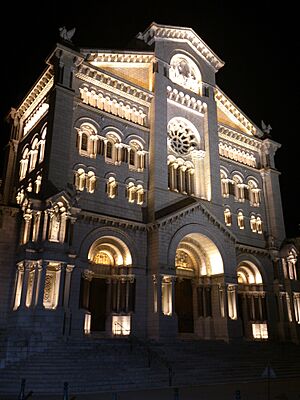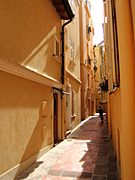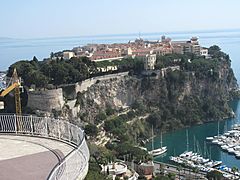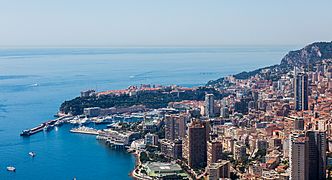Monaco City facts for kids
Quick facts for kids
Monaco City
|
|
|---|---|
|
Ward
|
|
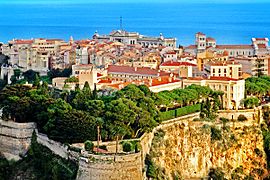
View of Monaco City
|
|
| Nickname(s):
The Rock
|
|
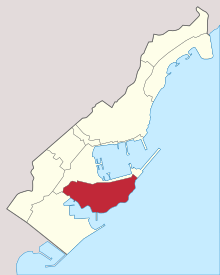
Location in Monaco
|
|
| Country | |
| Area | |
| • Land | 0.196491 km2 (0.075866 sq mi) |
| Population
(2008)
|
|
| • Total | 975 |
| • Density | 4,962/km2 (12,850/sq mi) |
Monaco City (also called Monaco-Ville in French) is a special part of the small country of Monaco. It sits on a rocky piece of land that sticks out into the Mediterranean Sea. People often call it "The Rock" (Le Rocher).
Even though it has "City" in its name, it's more like a historic neighborhood than a big city. This area is super important because it's where many of Monaco's main government buildings are. You'll find the Prince's Palace, the town hall, and the parliament here.
Contents
Where is Monaco City?
Monaco City is one of the four main areas of Monaco. The other areas are La Condamine, Monte Carlo, and Fontvieille.
It is located at 43°43′51″N 7°25′26″E / 43.73083°N 7.42389°E. About 975 people live here. It covers an area of about 0.2 square kilometers. This makes it a very small but important part of Monaco.
A Look Back: History of Monaco City
Monaco City has a long and interesting past. The ancient Greeks first called this place Monoikos. This name came from a temple dedicated to the hero Hercules.
In the 6th century BCE, people from a Greek city called Massalia (now Marseille) started a colony here. They believed Hercules had traveled through this area.
Building the Fortress
On June 10, 1215, a group of people called the Ghibellines started building a strong fortress on The Rock. They wanted it to be a key military spot. It helped them control the surrounding area.
They also built homes at the base of The Rock for the soldiers and their families. To get more people to move there, they offered land and no taxes to newcomers from Genoa and nearby towns.
The Grimaldi Family Takes Over
On January 8, 1297, a man named François Grimaldi took control of the fortress. He didn't have a big army. Instead, he dressed up like a Franciscan monk to trick the guards and get inside. Once he was in, he opened the gates for his soldiers.
This clever trick earned him the nickname "Malizia," which means "malice." Because of this story, the coat of arms of Monaco today shows two Franciscan monks holding swords. This event marked the beginning of the Grimaldi family's rule in Monaco.
Cool Places to See in Monaco City
Even though Monaco City is in the middle of a busy area, it feels like a quiet, old village. Most of its streets are for walking only. It gets very peaceful after the sun goes down. Only local cars can drive up to The Rock.
Here are some famous places you can visit:
- Prince's Palace: This is where the Prince of Monaco lives. You can watch the colorful changing of the guard ceremony every day at 11:55 a.m.
- Monaco Cathedral: This beautiful Catholic church is built in a Romanesque-Byzantine style. Many members of Monaco's ruling family are buried here.
- Oceanographic Museum: Prince Albert I started this museum in 1910. It's a famous place to learn about ocean life.
- Chapel of Mercy: Built in 1639, this is one of the oldest buildings in Monaco. It's known for a special torchlit procession that happens every year before Good Friday.
- St Martin Gardens: This is a small park with rocky paths that follow the edge of The Rock. It offers great views.
- Museum of the Chapel of Visitation: This is a 17th-century chapel that now serves as an art museum.
- Fort Antoine Theatre: This is an outdoor theater (an amphitheater) located at the bottom of The Rock.
Famous People from Monaco City
- Beatrice Borromeo, Italian journalist
- Andrea Casiraghi, Monégasque royal
- Charlotte Casiraghi, Monégasque royal
- Pierre Casiraghi, Monégasque royal
- Tatiana Casiraghi, Colombian-American socialite
- Ghislaine Dommanget, French actress and Princess of Monaco
- Daniel Ducruet, former guard in Monaco's royal company
- Louis Ducruet, Monégasque royal
- Gad Elmaleh, Moroccan actor
- Philippe Gilbert, Belgian cyclist
- Camille Gottlieb, Monégasque royal
- Albert Grimaldi, Prince of Monaco
- Caroline Grimaldi, Princess of Hanover
- Gabriella Grimaldi, Princess of Monaco
- Jacques Grimaldi, Prince of Monaco
- Rainier Grimaldi, former Prince of Monaco
- Stéphanie Grimaldi, Princess of Monaco
- Alexandra Hanover, Princess of Hanover
- Grace Kelly, American actress and Princess of Monaco
- Charlene Wittstock, South African swimmer and Princess of Monaco
- Charles Leclerc, Monégasque Formula 1 driver
Gallery
See also
 In Spanish: Mónaco-Ville para niños
In Spanish: Mónaco-Ville para niños
- Municipality of Monaco


